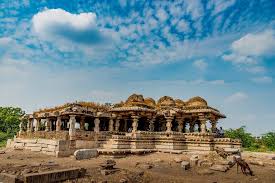The Deval Masjid stands out because of its unique architectural blend of Hindu and Islamic styles. The structure retains many elements of Hindu temple architecture, such as intricate stone carvings, pillars, and sculptural details, which are typical of Kakatiya temples. The Islamic architectural additions include the mihrab (a niche indicating the direction of Mecca) and the minarets, elements that reflect the building’s conversion into a mosque.
The mosque's stone pillars and the remains of Hindu iconography, particularly in its foundational design, are a testament to the craftsmanship of the Kakatiya era. The ornate carvings on the pillars and ceilings, featuring motifs like lotus flowers and mythical creatures, prove its original use as a Hindu place of worship.
The Deval Masjid stands out because of its unique architectural blend of Hindu and Islamic styles. The structure retains many elements of Hindu temple architecture, such as intricate stone carvings, pillars, and sculptural details, which are typical of Kakatiya temples. The Islamic architectural additions include the mihrab (a niche indicating the direction of Mecca) and the minarets, elements that reflect the building’s conversion into a mosque.
The mosque's stone pillars and the remains of Hindu iconography, particularly in its foundational design, are a testament to the craftsmanship of the Kakatiya era. The ornate carvings on the pillars and ceilings, featuring motifs like lotus flowers and mythical creatures, prove its original use as a Hindu place of worship.
